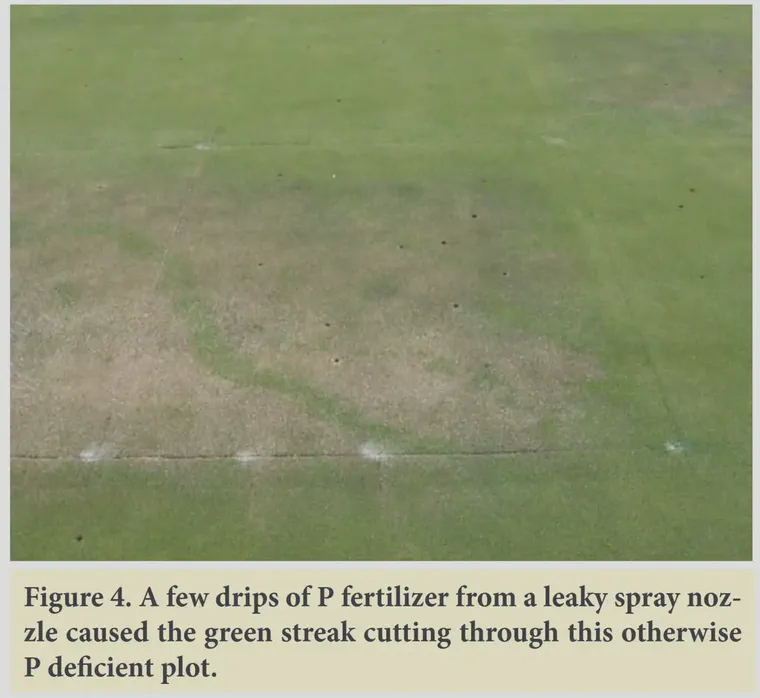How much phosphorus does grass require?
Phosphorus is an essential element for healthy turfgrass plants, but phosphorus can also contribute to algal growth in natural water bodies, so turfgrass managers should try to apply only the amount of phosphorus that is required by the grass.
How much phosphorus is enough? An article by Doug Soldat and Bill Kreuser includes this very interesting photo showing a phosphorus deficient turf, but green and healthy bentgrass growing where a leaky spray boom had spilled a phosphorus fertilizer onto the turf.

Phosphorus deficiency symptoms, which appear as purple turfgrass and apparently drought-stricken plants, can occur at Wisconsin when the soil phosphorus is less than 10 ppm on a Mehlich 3 soil test. The MLSN guideline for phosphorus is 21 ppm, a relatively generous amount when compared to the levels at which one sees deficiency symptoms, but still lower than conventional guidelines. Soldat and Kreuser have concluded that “Mehlich 3 soil test phosphorus requirement for sand based creeping bentgrass putting greens is likely not greater than 15 ppm.”
Dr. Soldat has compared phosphorus to a light switch, noting that when there is enough phosphorus, the grass grows very well (light switch on), and when there is not enough phosphorus in the soil (light switch off), the grass does not grow well at all. But adding more phosphorus beyond what the grass needs, which is probably somewhere below 15 ppm, or the generous 21 ppm as per the MLSN guideline, will have no effect on the grass, will certainly cost money but provide no benefit in turfgrass quality, and will have the potential to cause pollution of water bodies through leaching or runoff. So we should try to minimize the amount of phosphorus fertilizer applied.
Creeping bentgrass can grow perfectly well at a soil phosphorus level of 21 ppm (on the Mehlich 3 test), and in one year we can expect to remove about 1 g P m-2 for every 8 g of N applied per m2 though the collection of grass clippings. For each gram of P removed in clippings, the soil test P will go down by about 7 mg/kg (ppm). If the soil test P is at 100, 200, or 300 ppm, that represents something like five to fifteen years’ supply of P, sitting right there in the rootzone.
What do I recommend?
- Test your soil every year to ensure you will have healthy turfgrass, will not waste money on unnecessary fertilizer applications, and will minimize the chance of any pollution
- If you have soil phosphorus levels at more than 21 ppm on the Mehlich 3 test, you will not see a turfgrass response from applying more phosphorus, so save your money and don’t apply phosphorus in those situations
- Be very careful about the amount of nitrogen fertilizer that you apply, recognizing that nitrogen is the element that will control the growth of the grass and the uptake of other mineral nutrients
Note on 26 July 2017: I’ve updated this post twice since I first wrote it eight years ago. I think in the first version I suggested keeping P at 35 ppm and not applying when soil P was above 35. That of course was before the MLSN guidelines were introduced in 2012, and that first version of the guidelines had a minimum for P of 18 ppm. I’ve updated this post again to adjust to the current version of the MLSN guidelines, which has a P minimum of 21.